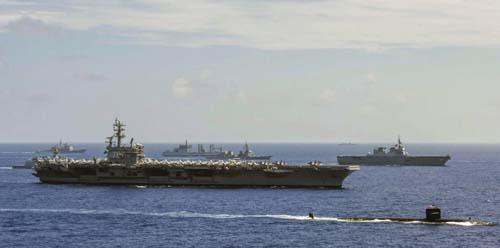Dualistic Thinking
2018-09-11ByHeXianqing
By He Xianqing

At the Indo-Pacific Business Forum in Washington, D.C. in late July, U.S. Secretary of State Mike Pompeo gave a speech titled Americas Indo-Pacifi c Economic Vision to promote the U.S. Indo-Pacifi c strategy initiated by the Donald Trump administration. Days later, during his trip to the East Asia Summit (EAS) Foreign Ministers Meeting and related gatherings, Pompeo used the occasion to further peddle the U.S. strategy in the name of advancing a so-called free and open IndoPacifi c region.
The Indo-Pacifi c strategy was unveiled by Trump at the APEC CEO Summit in Viet Nam in late 2017 before a few more details were added to the U.S. National Security Strategy of that year. In June 2018, U.S. Secretary of Defense James Mattis pointed out at the Shangri-La Dialogue that the United States plans to build more of a geopolitical military alliance than an economic one in the Indo-Pacific region, and Pompeos recent reiteration of the strategy at the EAS Foreign Ministers Meeting indicated that the vision is starting to become reality.
Economy and security
The U.S.-led Indo-Pacifi c strategy is a refl ection of Washingtons Cold War mentality. A key part of the initiative is to enhance interaction among the United States, Japan, Australia and India, as well as strengthening relations with other U.S. partners in the region. The United States regards China as a strategic adversary and vilifi es it as a revisionist country. At the same time, it tries to draw countries into its alliance with promises of political and economic benefi ts, and smears Chinas activity in the South China Sea as en- dangering peace and stability in the region. Through these methods, the United States seeks to attract allies while at the same time alienating China by exaggerating the threat it poses, with the ultimate goal of containing its rise.
The U.S. Indo-Pacific strategy also reveals an obvious intention to counter the China-proposed Belt and Road Initiative. At the beginning of 2018, the United States proposed its infrastructure investment plan in Asia during a quadrilateral meeting with Japan, Australia and India, citing the strong geo-economic implications of the Belt and Road Initiative and the need to respond to it. Moreover, rumors began to circulate that the Belt and Road Initiative would increase the debt burden of participating nations, eventually subjecting them to the political authority of Beijing.
In its vision for the Indo-Pacific region, the United States announced that $113 million would be invested in supporting foundational areas of the future—the digital economy, energy and infrastructure—as a down payment on its economic commitment. Though Pompeo claimed that the plan excludes no nation and seeks to work with everyone to promote a free and open Indo-Pacifi c region, China, in the context of mounting U.S. protectionism and the ongoing trade war initiated by Trump, clearly does not meet the criteria.
Deep-rooted reasons
The main goal of the Indo-Pacific strategy is to maintain U.S. hegemony in the region. After the collapse of the Soviet Union, the Western world hailed the victory of U.S. democracy with hubristic declarations of “the end of history,” and the historic pattern of confrontation between two major powers was replaced by U.S. global hegemony. In recent years, politicians from the United States have come to believe that the rise of China challenges the U.S.-led international order. In other words, since the end of the Cold War, the United States has regarded China as the major threat to its global hegemony, and measures have been and are being taken to contain the further development of the East Asian powerhouse.
U.S. trade protectionism and anti-globalization also seem born of this same brand of exclusiveness. Under the banner of America First, Trump decided to withdraw from the Trans-Pacifi c Partnership (TPP) and other multilateral arrangements, revealing to the world his view that the United States is the victim of multilateral cooperation and the current free trade system. The United States has used this position to disturb current international governance, the real intention of which is to build up a new regional and global order and exclude those countries that do not accord with U.S. interests, especially China.
A Puritan religious gene is one of the undertones of U.S. foreign policy, and has facilitated its expansion ever since the establishment of the United States as a nation. Several years ago, the United States adopted an inclusive policy on China, accepting Chinas presence in international structures, while expecting it to develop into a country molded in its image. But as Chinas strength grows, the United States has grown ever more concerned about its power. In view of the United States today, engaging with China has not “saved” it, but instead made it stronger. Thus, China, a country that wont meet U.S. standards of freedom and openness, now has to be restrained.
In short, the Indo-Pacifi c strategy is conceived on the basis of dualistic thinking with the aim of excluding those countries that threaten U.S. national interests. In reality the so-called free and open Indo-Pacifi c strategy is neither free nor open.
Regional interests
The key to the success of the U.S. IndoPacifi c strategy also depends on the support of the countries in the region, and whether those countries are set to benefit from it. The purpose of the initiative, characterized by U.S. dominance and standards, is to establish an exclusive bloc to contain China, but neither its methods nor goals are in line with the interests of the countries in the region.
The U.S.-led process of establishing a regional order is not in the strategic interests of the other countries involved. Countries in the region have long competed for dominance in the construction of a regional order. India has always viewed the Indian Ocean as its backyard and pursued leadership in the area. If an exclusive clique dominated by the United States is formed, India will lose its flexibility to maneuver between China and the United States. Furthermore, India may have to yield to the dominance of the United States, which would harm its own strategic interests. At the Shangri-La Dialogue, Indian Prime Minister Narendra Modi stressed that the Indo-Pacific region is more of a geographical concept than a strategic one, stating that “India does not see the IndoPacific region as a strategy or as a club of limited members.” In his speech, Modi not only expressed the importance of the Indian Ocean to India, but also set out Indias six major visions for the Indo-Pacifi c region, explicitly rejecting the idea of creating a clique. And ASEAN too has always emphasized its centrality and independence in regional affairs.
U.S. standards also do not serve the economic and development interests of countries in the region. A “free” Indo-Pacifi c region, according to Pompeo, means that all nations are able to protect their sovereignty from coercion by other countries. At the national level, “free” means good governance and the assurance that citizens are able to enjoy fundamental rights and liberties. Economically, an “open” Indo-Pacifi c means fair and reciprocal trade, open investment environments, transparent agreements between nations and improved connectivity to drive regional ties.
While “free and open” may sound nice, the implicit premise is that any new structure is still led by the United States. In the Philippines for example, the anti-drug and anti-terror war waged by President Rodrigo Duterte to improve its domestic governance has been accused by Washington of violating human rights. The United States has also turned a blind eye to the efforts of China and ASEAN to maintain peace and stability in the South China Sea. China and ASEAN recently agreed on a single draft negotiating text of the Code of Conduct on the South China Sea, an important step toward the settlement of regional maritime disputes. Instead, the United States has been increasing its own military operations in the area.
Economic openness is another excuse for the United States to push forward with trade protectionism, while its purpose is to establish a unilateral U.S.-led trade system. Given the overwhelming economic and political advantages of the United States, it would be diffi cult for any Indo-Pacifi c nation to benefi t from such a system.
In reality, Pompeos protectionist and antiglobal predilections were shunned at the EAS Foreign Ministers Meeting because Southeast Asian countries are aware that they have little to gain from the U.S. Indo-Pacifi c strategy. The United States withdrawal from the TPP has awakened its allies to the damage that trade protectionism brings. Japan, for this very reason, has changed its attitude toward the Belt and Road Initiative and expressed its willingness to cooperate more closely with China. Southeast Asian nations have also chosen to maintain their close cooperation with China under the framework of the Belt and Road Initiative.
The Indo-Pacific strategy is, in a word, aimed at maintaining the hegemony of the United States by political and economic means and constructing a U.S.-dominated unilateral trade system. Not only will China ultimately be forced to confront containment by the United States, but other countries of the Indo-Pacific region look to benefit little from such an exclusive strategy.
